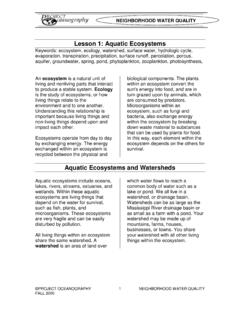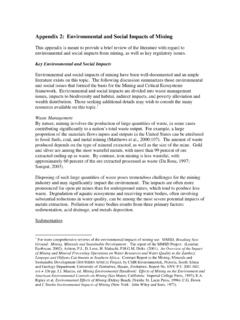Transcription of The ecosystem approach FAO FISHERIES PAPER
1 ISSN 0429-9345. The ecosystem approach FAO. FISHERIES . to FISHERIES TECHNICAL. PAPER . Issues, terminology, principles, 443. institutional foundations, implementation and outlook - iii - PREPARATION OF THIS DOCUMENT. This desk review of relevant aspects of an ecosystem approach to FISHERIES (EAF) was specifically prepared to facilitate the work of the FAO Technical Consultation on the ecosystem -based FISHERIES Management held in Reykjavik (Iceland) from 16 to 19 September 2002. It was intended to be used as background material and source of definitions and references for the EAF. guidelines to be elaborated at the meeting. A much shorter version was presented at the Symposium on Marine FISHERIES , ecosystems , and Societies in West Africa: Half a Century of Change, held in Dakar (Senegal) from 26 to 28 June 2002.
2 The draft received comments and additional inputs during and after the meeting from many participants, particularly Drs D. Staples and K. Cochrane. Distribution: All FAO Members and Associate Members Interested Nations and International Organizations FAO FISHERIES Department FAO Fishery Officers in FAO Regional Offices Interested Non-governmental Organizations - iv - Abstract Garcia, ; Zerbi, A.; Aliaume, C.; Do Chi, T.; Lasserre, G. The ecosystem approach to FISHERIES . Issues, terminology, principles, institutional foundations, implementation and outlook. FAO FISHERIES Technical PAPER . No. 443. Rome, FAO. 2003. 71 p. ecosystems are complex and dynamic natural units that produce goods and services beyond those of benefit to FISHERIES .
3 Because FISHERIES have a direct impact on the ecosystem , which is also impacted by other human activities, they need to be managed in an ecosystem context. The meaning of the terms ecosystem management , ecosystem - based management , ecosystem approach to FISHERIES (EAF), etc., are still not universally defined and progressively evolving. The justification of EAF is evident in the characteristics of an exploited ecosystem and the impacts resulting from FISHERIES and other activities. The rich set of international agreements of relevance to EAF contains a large number of principles and conceptual objectives. Both provide a fundamental guidance and a significant challenge for the implementation of EAF.
4 The available international instruments also provide the institutional foundations for EAF. The FAO Code of Conduct for Responsible FISHERIES is particularly important in this respect and contains provisions for practically all aspects of the approach . One major difficulty in defining EAF lies precisely in turning the available concepts and principles into operational objectives from which an EAF management plan would more easily be developed. The PAPER discusses these together with the types of action needed to achieve them. Experience in EAF. implementation is still limited but some issues are already apparent, in added complexity, insufficient capacity, slow implementation, need for a pragmatic approach , etc.
5 It is argued, in conclusion, that the future of EAF and FISHERIES depends on the way in which the two fundamental concepts of FISHERIES management and ecosystem management, and their respective stakeholders, will join efforts or collide. -v- Contents Page INTRODUCTION 1. 1. TERMINOLOGY AND PARADIGMS 3. FISHERIES Management 3. ecosystem Management 4. ecosystem approach 5. ecosystem -based FISHERIES Management (EBFM) 6. ecosystem approach to FISHERIES (EAF) 6. Integrated Management (IM) 7. 2. ecosystem CHARACTERISTICS 7. Definition 7. Scale and Boundaries 7. Dynamics and Natural Variability 8. Biological Organization 8. Structure 9. 3. FISHERIES IMPACT ON THE ecosystem 9.
6 Overall Impacts 10. Impact on Associated and Dependent Species 10. Impact on the Environment 11. Poor Selectivity, Bycatch and Discards 12. Gear Loss and Ghost Fishing 12. 4. FISHERIES VERSUS OTHER IMPACTS 12. Overall Impacts 12. Relative Importance of FISHERIES and Other Impacts 13. The Black Sea Example 13. Impact on Diadromous Fish 14. Competition B etween Humans and Marine Mammals 14. Allocation Implications 14. 5. INSTITUTIONAL FOUNDATIONS 15. 6. RELEVANCE OF THE CODE OF CONDUCT 19. Respect for the ecosystem 19. Account of the Environment 19. Biodiversity and Endangered Species 20. Species Interdependence 20. General Impact from FISHERIES 20. Selectivity, Ghost Fishing, Bycatch, Discards and Waste 20.
7 Impact from Other Activities 20. Improved Governance 21. - vi - Uncertainty, Risk and Precaution Page 21. Integrated Management 21. 7. EAF PRINCIPLES 21. Human and ecosystem Well-being 22. Resource Scarcity 22. Maximum Acceptable Fishing Level 22. Maximum Biological Productivity 23. Impact Reversibility 23. Impact Minimization 23. Rebuilding of Resources 23. ecosystem Integrity 23. Species Interdependence 24. Institutional Integration 24. Uncertainty, Risk and Precaution 24. Compatibility of Management Measures 24. The Polluter Pays Principle (PPP) 25. The User Pays Principle (UPP) 25. The Precautionary Principle and Precautionary approach 25. Subsidiarity, Decentralization and Participation 25.
8 Equity 26. 8. OPERATIONAL OBJECTIVES AND MEASURES 26. Targets, Constraints, Indicators and Reference Points 27. Priority Setting 28. Improving Conventional Management 28. Improving ecosystem Well-being 29. Rebuilding ecosystems 30. Maintaining Reproductive Capacity of Target Resources 31. Maintaining Biological Diversity 32. Protecting and Enhancing Habitats 32. Protecting Selected Marine Areas 35. Reducing Bycatch and Discards 36. Reducing Ghost Fishing 36. Reducing Uncertainty and Risk 36. Improving the Institutional Set-up 37. Matching Jurisdictional and EAF Boundaries 38. Improving the Decision-making Framework 39. Improving Statistics and Inventories 40. Monitoring and Indicators 41.
9 Improving Research Capacity 42. Management Planning 43. Certification 44. 9. IMPLEMENTATION ISSUES 44. EAF: Hurdle or Opportunity? 44. Rhetoric Versus Commitment 45. Capacity, Pragmatism and Stepwise Implementation 45. The Need for Subsectoral Approaches 46. Role of NGOs 46. DISCUSSION: FUSION OR COLLISION? 47. - vii - BIBLIOGRAPHY Page 50. Annex 1: Malawi Principles for the ecosystem approach 59. Annex 2: Key Events in the Evolution of FISHERIES and ecosystem Management 61. Annex 3: Glossary 65. INTRODUCTION. Any analysis of the state of FISHERIES and their resources needs to be undertaken in its broader aquatic context. In that respect, most aquatic environments indicate a lack of stewardship, illustrated by growing degradation, loss of habitat, lack of coherence in aquatic science policy, inadequate management-oriented research, poor or inexistent long-term monitoring, lack of strategic, integrated planning of conflicting uses, etc.
10 The relative failure of conventional FISHERIES management has been abundantly described (Garcia, 1992; Garcia, 1996a; Garcia and Grainger, 1997; Sutinen and Soboil, 2003, and many others). The realization of the need to exert some form of control over multiple uses of a sea area emerged during the late twentieth century as a result of concerns over the health of the oceans, the regulation of human activities, the allocation of space, resources, rights and responsibilities, and the growing occurrence of related conflicts. In the process, the division of resources among nations (through the establishment of sovereign rights) seems to have been given priority over the issue of their conservation for future generations.
















